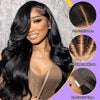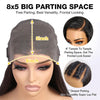Hair Grade Chart: The Differences Among 6A Hair, 8A Hair, 10A Hair, 12A Hair, And 15A Hair
6A hair, 8A hair, 10A hair, 12A hair, and 15A hair are terms that are used to describe the grade of the hair. You must have heard of them before, but you may still be confused about these concepts.
This blog will explain the hair grade system clearly across 5 different aspects in detail.
By the end, you will have a clear and systematic understanding of the hair grade system.
What’s more, you can also better distinguish the differences among 6A hair, 8A hair, 10A hair, 12A hair, and 15A hair.
If you want to purchase hair wigs, this blog can help you make the decision.
1. What do hair grades mean?
Hair grades are a way to classify the quality of the hair. They give buyers an idea of the texture, lifespan, and price point of the product. The higher the grade number, the better the overall quality.
These grades typically refer to:
(1)Hair Quality: Whether it’s raw, virgin, remy, or non-remy hair.
(2)Durability: How long the hair maintains without shedding, tangling, or breaking down.
(3)Cuticle Alignment: Whether the cuticles are intact and running in the same direction.
(PS: The cuticle is located on the outermost layer of the hair and is an important component of the hair, which can directly affect the appearance and texture of the hair.)
(4)Hair Processing: The level of chemical processing done to achieve the desired texture and color.
(5)Single or double drawn hair: There is no doubt that double drawn hair is better than single drawn hair, because the hairs in the bundle are of uniform length.
In fact, the biggest difference is the ratio of relatively shorter hairs in a bundle. The higher the grade, the lower the percentage of short hairs in a bundle.
In other words, the higher the number, the higher the grade.
2. Where does the hair grade system come from?
The hair grade system comes from the manufacturer that sources the hair from the donor.
Actually, there is no universal “best” grade of hair, and the hair grades are just what companies use to describe the hair they sell. Every company can define its own hair grading system to describe the quality of its products.
So when comparing two companies with the same hair grade, we can’t judge hair quality by hair grade number, and we should look for other ways to ensure the quality of the hair.
3. How does the hair grade system work?
The hair grade system gives people different options, and they can clearly see distinctions among different qualities. It actually refers to the proportion of strands per bundle that measures the full length of the bundle rather than determines the quality of the hair.
The hair grade system can help some customers find quickly the hair they want in their budget.
4. The definitions of 6A hair, 8A hair, 10A hair, 12A hair, and 15A hair
(1)6A Hair:
6A hair is typically made of 100% human hair, but the quality is lower than higher-grade hair. Besides, 6A hair has undergone more processing to achieve various looks, such as bleaching, dyeing, or texturizing.
6A hair extensions are the entry-level option for people seeking a blend of affordability and style for special events. However, it doesn’t hold up as well to frequent styling, washing, or heat treatment.
(2)8A Hair:
8A hair is often made of 100% remy hair, meaning it hasn’t been chemically processed and retains its natural strength and softness.
8A hair extensions are versatile and can withstand more styling than 6A hair. They are an excellent choice for people wanting a natural look and longer-lasting extensions without the high price tag.
(3)10A Hair:
10A hair is often made of 100% virgin human hair, ensuring minimal processing and excellent cuticle alignment.
10A hair extensions are where luxury meets performance. If you’re looking for high-quality extensions that offer a natural feel, minimal maintenance, and long-lasting durability, this grade is for you.
10A hair extensions offer excellent versatility, allowing you to color, style, and heat-treat them without damaging the hair.
These extensions maintain their texture and volume even with frequent use, making them a top choice for those who want a premium hair experience.
(4)12A Hair:
12A hair consists of 100% virgin human hair, often collected from a single donor to ensure the cuticles are intact and aligned.
At the top of the grading scale, 12A hair extensions are the ultimate choice for those who want the best quality available. 12A extensions are designed for those who prioritize durability, longevity, and a flawless appearance.
12A hair extensions are designed to withstand heavy styling, including bleaching and dyeing, without losing their natural texture or shine.
If you’re looking for high-quality hair that can last for years, 12A is the perfect choice.
(5)15A Hair:
15A hair is often made of 100% unprocessed virgin human hair from a single donor that has remained intact with its cuticles aligned in the same direction, and its natural structure is preserved. This makes the hair soft, smooth, and less prone to tangling or matting.
15A hair is considered the pinnacle of quality in this system. Because of its premium characteristics, 15A hair is often used for luxury wigs, extensions, or weaves.
The following is a chart that can help you better understand the hair grade system, which will be helpful to you.

5. The differences of 6A hair, 8A hair, 10A hair, 12A hair, and 15A hair
The following is a table that can help you better understand the differences among 6A hair, 8A hair, 10A hair, 12A hair, and 15A hair.
| Price | Hair Type | Lifespan | Texture | |
|---|---|---|---|---|
| 6A Hair Extensions | Budget-friendly, making them accessible for beginners. | Usually, remy hair. | It can last 2-4 months with proper care. | Soft but lacks the shine and durability of higher grades. |
| 8A Hair Extensions | Mid-range, offering a balance between affordability and quality. | Typically made of virgin remy hair with cuticles intact and aligned. | It can last up to 12 months with proper care. | Smoother and shinier than 6A hair, with better resistance to tangling and shedding. |
| 10A Hair Extensions | Higher price point, but worth the investment for long-term use. | Virgin remy hair, typically single-donor hair, meaning all strands come from one person. | It can last 1-2 years with proper care. | Ultra-soft, smooth, and shiny with no tangling or shedding issues. |
| 12A Hair Extensions | Expensive but a worthy investment for luxury seekers. | Raw, single-donor hair with perfect cuticle alignment. | It can last 2-3 years with proper maintenance. | Silky, soft, and shiny with zero tangling or shedding, even after extensive use. |
| 15A Hair Extensions | The most expensive but excellent investment for people looking to achieve a natural and long-lasting hairstyle. | 100% unprocessed virgin human hair, sourced from a single donor. | It can last up to 3-5 years with proper care due to its premium quality. | Silky, soft, and smooth, mimicking natural, healthy human hair. |
Conclusion:
After finishing the passage, you must have a better understanding of the hair grade system, and can distinguish the differences among 6A hair, 8A hair, 10A hair, 12A hair and 15A hair clearly.
If you want to buy a wig, you should decide which hair grade to purchase based on your budget and your demands. Please remember that the most expensive one is not necessarily the best, and the one that suits you most is the best.
It’s my pleasure if this blog can really help you.
If you have any questions about human hair wigs, please feel free to email me, and I will always be here to help you!


















































Leave a comment